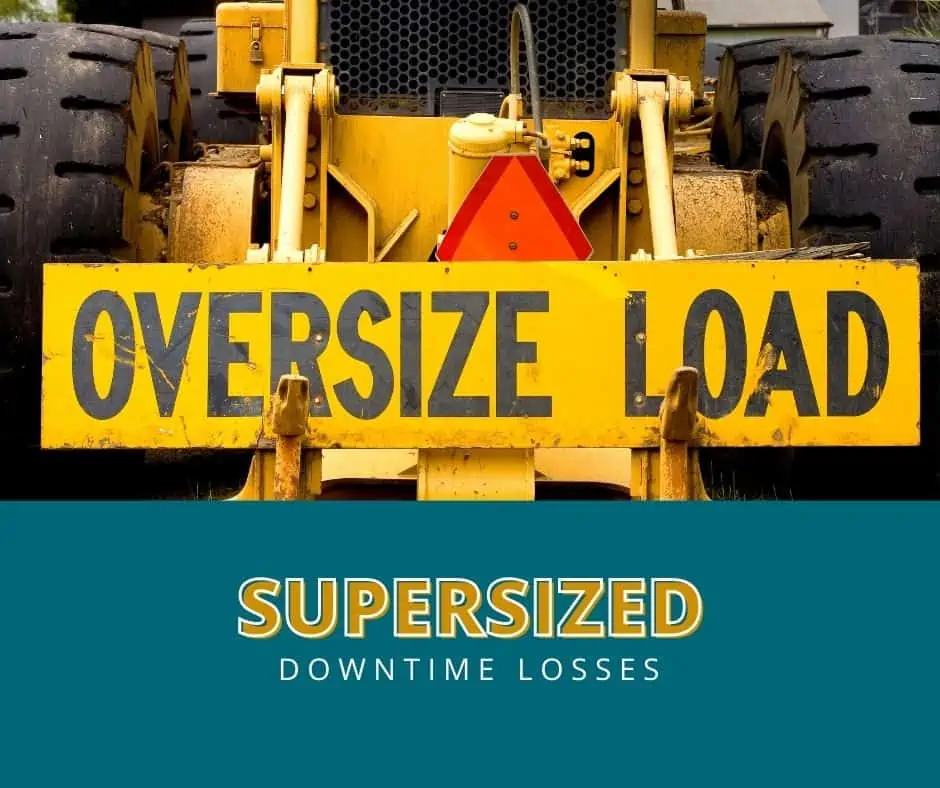Kyle hauls supersized windmill blades throughout the Midwest. He has an impeccable safety record. But last month, his tractor trailer was hit by a woman driving a car insured by Geico.
The damage put Kyle out of service for two months, resulting in a supersized loss of income of $45,000. Geico agreed to pay for the repairs, but only wanted to pay Kyle $150 per day for his downtime losses. Geico said Kyle should have rented equipment, and they based their offer on a rental rate of $150 per day. Kyle laughed, knowing there was no rental company that would have the type of equipment he needed, on a short-term basis, especially at that price.
Highly Specialized Equipment = Supersized Downtime Losses:
As anyone in the transportation industry knows, oversize tractors and trailers are unique pieces of equipment. They are often highly specialized to haul specific types of heavy and oversize loads. These loads also often require permits, escorts, and other safety precautions.
Some of the cargo hauled by these super transporters include not only windmill blades, but land movers, oil field equipment, tanks, massive coils and other heavy industrial equipment. While the drivers of these big rigs are some of the safest on the road, other drivers are not necessarily so safe. And, when an unsafe driver damages a super rig, losses pile up extra fast.
The bigger the freight, the longer and wider the trailer that’s needed. 7, 8 and 9 axle trailers can haul some amazingly sized loads. Rarely can this equipment be replaced short term while being repaired from an accident.
Most specialty equipment isn’t available at Ryder or Penske rental shops. So, when an oversize trailer is down, the business is down. In many cases, there’s nothing to do but push to get the repairs done as quickly as possible. No other mitigation may be possible or reasonable.
After an Accident:
What is an owner operator or fleet owner to do when an accident happens to their specialty equipment?
1) Prove liability
2) Prove damages
First, you must prove the other side was at fault for the accident. Your business could have huge losses, but if you can’t prove the other side’s at fault, you won’t win.
Second, you must prove what you lost. Losses include repairs, diminished value, lost income, any bodily injury expenses and other out of pockets.
Filing an Insurance Claim for the Supersized Losses:
Kyle had to decide whether to file a claim with his own insurance company or Geico, the bad driver’s insurance company. Kyle, of course, didn’t want to file with his own insurance company, but he checked with his motor carrier and insurance agent just to be safe. Had Geico not agreed to pay the repairs timely, Kyle may have had to file with his own insurance.
Just like Kyle, it’s important to look at all the options and make the best decision for your business. You may wish to discuss your options with your insurance agent, safety director, or attorney to have the full picture.
While the other side and their insurance company may try to make things right, you are the only one that will probably care about making things right quickly. Time is money. With every day that passes after an accident, your business loses money until that equipment is back on the road.
FMCSA Part 393- Parts and Accessories Necessary for Safe Operation:
Not everyone outside the transportation industry understands the requirements truckers must abide by to stay legal on the roadways. The requirements are heightened when the equipment and loads are supersize. After an accident, the other driver’s insurance company may deny a downtime request stating the equipment’s drivable, so it should have continued to haul loads. However, there’s a vast difference between drivable and DOT-approved drivable.
FMCSA Part 393 is very clear as to which parts on a truck and trailer are absolutely required for safe driving. Sure, you might be able to technically drive a truck with blown headlights, a broken speedometer and a bent hood, but that doesn’t mean it’s fit to haul loads cross country.
Document Everything!
Do yourself a favor and document everything at the accident scene to prove your case. Take more pictures from more angles than you think you could possibly need.
Keep every repair receipt and other out of pocket expense relating to the accident in a folder. You want to make it easy on the insurance adjuster to pay your claim. Anything not documented may not be reimbursed, so consider paying expenses with a check or credit card rather than cash. If you pay with cash, get a receipt.
While it doesn’t seem fair, it’s your job to show you used reasonable measures to get your equipment back on the road. Keep a diary of everything done to get back on the road. If parts were delayed, get proof.
Protect Yourself, Your Family and Your Business:
You’re your own best advocate. Stand up for your business and push for a quick resolution. No one’s going to care about getting your equipment back to work like you do. As you know, it’s easy for a trucking business to get upside down very quickly after an accident because of the high cost of operation.
If you need help, ask for it. Professionals are available to help at any point in the process. Get the claim resolved and get back to work for your family’s sake. Because as the saying goes, “If those wheels ain’t turning, you ain’t earning.”
